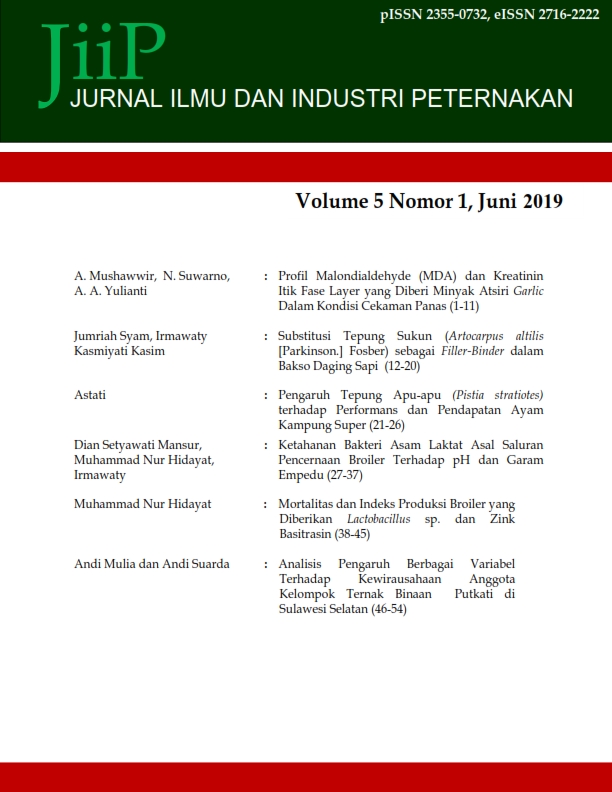Profil Malondialdehyde (MDA) dan Kreatinin Itik Fase Layer yang Diberi Minyak Atsiri Garlic Dalam Kondisi Cekaman Panas
Abstract
Cekaman panas menyebabkan peningkatan radikal bebas. Radikal bebas mampu mengoksidasi PUFA sehingga kadar MDA bertambah serta menyebabkan pemanfatan sumber energy yaitu kreatin fosfat, untuk mendukung kontraksi otot-otot jantung dan otot terkait respirasi dalam mengevaporasikan panas tubuh itik. Kondisi ini berdampak negatif bagi ternak itik. Untuk itu telah dilakukan penelitian untuk mengetahui efek pemberian minyak atsiri untuk menanggulangi sintesis MDA dan kreatinin pada itik. Empat puluh empat ekor itik cihateup berjenis kelamin betina, berumur 25 bulan telah digunakan, dibagi dua kelompok, masing-masing 22 ekor tidak diberi minyak atsiri dan 22 ekor lainnya diberi minyak atsiri 0.5 mL/kg BB per 2 hari. Itik dipelihara selama 2 bulan. Pemberian pakan diatur 215 g/ekor perhari selama penelitian. Isolasi minyak atsiri dilakukan dengan menggunakan metode penguapan distilasi. Sampel darah dari tiap-tiap ternak dikoleksi pada akhir penelitian, menggunakan tabung venojette ber-EDTA 5 mL. Sampel segera dicentrifuge untuk untuk memperoleh plasma dan hemolisat sel-sel darahnya. Plasma digunakan untuk menganalisis kadar kreatinnya, menggunakan teknik spektrofotometrik mengikuti prosedur kit BIOLABO, France. Hemolisat digunakan untuk menganalisis kadar MDA sampel, dengan teknik spektrofotometrik. Berdasarkan hasil penelitian disimpulkan bahwa minyak atsiri mampu menghambat sintesis malondialdehyde (MDA) dan kreatinin itik cihateup yang mengalami cekaman panas.
Downloads
References
Addabbo, F., Montagnani, M., and Goligorsky, M. S. 2009. Mitochondria and reactive oxygen species. Hypertension, 53, 885–892.
Aengwanich, W. 2007. Effects of high environmental temperature on blood indices of thai indigenous chickens, thai indigenous chickens crossbred and broilers. International Journal of Poultry Science,6, 427-430.
Allen R.G. 2000. Tressini M. Oxidative stress and gene regulation. Free Radical Biol Med. 28:463-99.
Bohmanova, K., and Chikamune, T. 2007. Comparison of Physiological Response to the Environments in Swamp Buffalo and Cattle Under a Temperate Condition. Dalam : H. Shimizu (Editor) Current Development and Problems in Swamp Buffalo Production. Proceedings of the Preconference Symposium of the 5th World Conference on Animal Production, Tsukuba. Japan: 107 – 127.
Bottje, W., Enkvetchakul, B., & Moore, R, 1995. Effect of α-tocopherols on antioxidants, lipid peroxidation, and the incidence of pulmonary hypertensio syndrome (ascites) in broilers. Poultry Science, 74, 1356-1369.
Dawson, W.R., and Whittow, G.C. 2000. Regulation of Body Temperature, in Sturkie’s Avian Physiology, 5thed., edited by Whittow, G.C.Academic Press, Elsevies Sci.Pub.Co., Sydney.
Soewoto, H., Sadikin, M., Kurniati, V., Wanandi, S.I. G.R., Dwirini. S.P., Abadi. Prijanti, R.A., Harahap, P.I., dan Jusman, A.W.S. 2001. Biokimia Eksperimen Laboratorium. Widya Medika, Jakarta
Solichadi. K. 2002. Pemanfaatan Kunyit (Curcuma domestika VAL) dalam Ransum Broiler Sebagai Upaya Menurunkan Lemak Abdominal dan kadar Kolesterol. Jurnal Pengembangan Peternakan Tropis Fakultas Peternakan Universitas Diponegoro, 27.
Inoue M. 2001. Protective Mechanisms Against Reactive Oxygen Species. In Arias IM The Liver Biology and Pathobiology LJippincott Williams and Wilkins 4th-ed. Philadelphia.
Kinanti, A.S.2011. Pengaruh suplementasi vitamin E dan DL methionine dalam ransum terhadap performa ayam broiler pada kondisi cekaman panas. Skripsi. Departemen Ilmu Nutrisi dan Teknologi Pakan, Fakultas Peternakan, Institut Pertanian Bogor, Bogor.
Mujahid, A., Akiba, Y., & Toyomizu, M.. 2007. Acute heat stress induces oxidative stress and decreases adaptation in young white leghorn cockerels by down regulation of avian uncoupling protein. Poultry Science, 86, 364-371.
Mushawwir, A. dan Latipudin, D. 2011. Beberapa parameter biokimia darah ayam ras petelur fase grower dan layer dalam lingkungan “upper zonathermoneutral’’. Jurnal Peternakan Indonesia, 13 (3) : 191-198.
Mushawwir, A. dan Latipudin. D.2012. Respon fisiologi thermoregulasi ayam ras petelur fase grower dan layer. Proceeding of National Seminar on Zootechniques, 1(1), 23-27.
Mushawwir A. dan D. Latipuddin. 2013. Biologi Sintesis Telur, Perspektif Fisologi, Biokimia dan Molekuler Produksi Telur. Penerbit Graha Ilmu, Yogyakarta.
Mushawwir, A. 2015. Biokimi Nutrisi. Widya Padjadjaran, Bandung.
Puvadolpirod, S. And Thaxton, J.P. 2000. Model of physiological stress in chickens 1. Response parameters. Poultry Science, 79, 363–369.
Rhoads, R.P., Baumgard, L.H., and Suagee, J. K. 2013. Metabolic priorities during heat stress with an emphasis on skeletal muscle. Journal Animal Science, 91, 2492–2503.
Shinder, D., Rusal, M., Tanny, J., Druyan, S., and Yahav, S. 2007. Thermoregulatory responses of chicks (gallus domesticus) to low ambient temperatures at an early age. Poultry Science, 86, 2200–2209.
Tan, G.Y., Yang , L., Y.-Q. Fu , Feng, J.H., and Zhang, M.H. 2010. Effects of different acute high ambient temperatures on function of hepatic mitochondrial respiration, antioxidative enzymes, and oxidative injury in broiler chickens. Poultry Science. 89, 115-122.
Wang, S. C., Chen, J., Huang, Y., Li, X.F., and Zhang, D.J. 2007. Effect of heat stress on production performance and blood biochemical indices in broiler. China Poultry, 15, 11-13.
Jurnal Ilmu dan Industri Peternakan (JIIP) is published under the terms of the Creative Commons Attribution license. Authors retain the copyright to their work. Users may read, copy and distribute the work in any medium provided the authors and the journal are appropriately credited.


